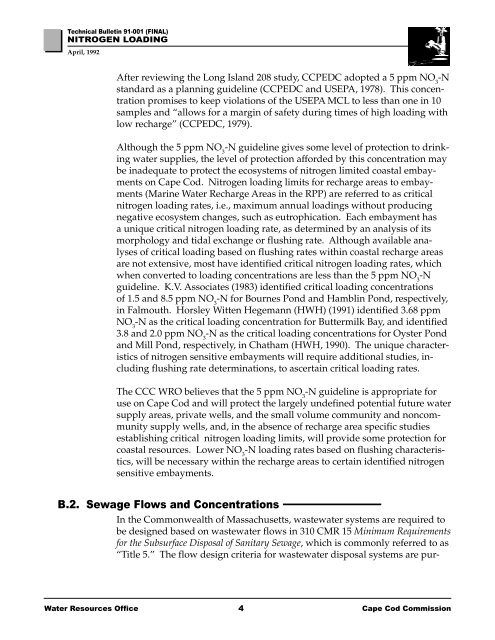Technical Bulletin 91-001 Nitrogen Loading - Cape Cod Commission
Technical Bulletin 91-001 Nitrogen Loading - Cape Cod Commission
Technical Bulletin 91-001 Nitrogen Loading - Cape Cod Commission
Create successful ePaper yourself
Turn your PDF publications into a flip-book with our unique Google optimized e-Paper software.
<strong>Technical</strong> <strong>Bulletin</strong> <strong>91</strong>-<strong>001</strong> (FINAL)<br />
NITROGEN LOADING<br />
April, 1992<br />
After reviewing the Long Island 208 study, CCPEDC adopted a 5 ppm NO 3<br />
-N<br />
standard as a planning guideline (CCPEDC and USEPA, 1978). This concentration<br />
promises to keep violations of the USEPA MCL to less than one in 10<br />
samples and “allows for a margin of safety during times of high loading with<br />
low recharge” (CCPEDC, 1979).<br />
Although the 5 ppm NO 3<br />
-N guideline gives some level of protection to drinking<br />
water supplies, the level of protection afforded by this concentration may<br />
be inadequate to protect the ecosystems of nitrogen limited coastal embayments<br />
on <strong>Cape</strong> <strong>Cod</strong>. <strong>Nitrogen</strong> loading limits for recharge areas to embayments<br />
(Marine Water Recharge Areas in the RPP) are referred to as critical<br />
nitrogen loading rates, i.e., maximum annual loadings without producing<br />
negative ecosystem changes, such as eutrophication. Each embayment has<br />
a unique critical nitrogen loading rate, as determined by an analysis of its<br />
morphology and tidal exchange or flushing rate. Although available analyses<br />
of critical loading based on flushing rates within coastal recharge areas<br />
are not extensive, most have identified critical nitrogen loading rates, which<br />
when converted to loading concentrations are less than the 5 ppm NO 3<br />
-N<br />
guideline. K.V. Associates (1983) identified critical loading concentrations<br />
of 1.5 and 8.5 ppm NO 3<br />
-N for Bournes Pond and Hamblin Pond, respectively,<br />
in Falmouth. Horsley Witten Hegemann (HWH) (19<strong>91</strong>) identified 3.68 ppm<br />
NO 3<br />
-N as the critical loading concentration for Buttermilk Bay, and identified<br />
3.8 and 2.0 ppm NO 3<br />
-N as the critical loading concentrations for Oyster Pond<br />
and Mill Pond, respectively, in Chatham (HWH, 1990). The unique characteristics<br />
of nitrogen sensitive embayments will require additional studies, including<br />
flushing rate determinations, to ascertain critical loading rates.<br />
The CCC WRO believes that the 5 ppm NO 3<br />
-N guideline is appropriate for<br />
use on <strong>Cape</strong> <strong>Cod</strong> and will protect the largely undefined potential future water<br />
supply areas, private wells, and the small volume community and noncommunity<br />
supply wells, and, in the absence of recharge area specific studies<br />
establishing critical nitrogen loading limits, will provide some protection for<br />
coastal resources. Lower NO 3<br />
-N loading rates based on flushing characteristics,<br />
will be necessary within the recharge areas to certain identified nitrogen<br />
sensitive embayments.<br />
B.2. Sewage Flows and Concentrations<br />
In the Commonwealth of Massachusetts, wastewater systems are required to<br />
be designed based on wastewater flows in 310 CMR 15 Minimum Requirements<br />
for the Subsurface Disposal of Sanitary Sewage, which is commonly referred to as<br />
“Title 5.” The flow design criteria for wastewater disposal systems are pur-<br />
Water Resources Office 4<br />
<strong>Cape</strong> <strong>Cod</strong> <strong>Commission</strong>
















